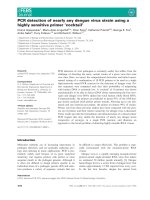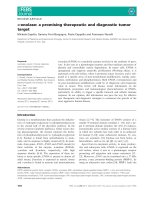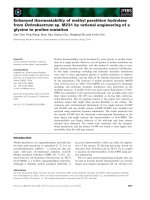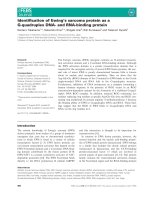Tài liệu Báo cáo khoa học: "A SNAPSHOT OF KDS A KNOWLEDGE" pot
Bạn đang xem bản rút gọn của tài liệu. Xem và tải ngay bản đầy đủ của tài liệu tại đây (96.72 KB, 2 trang )
A SNAPSHOT OF KDS
A
KNOWLEDGE DF_,LIVERY SYSTEM
James A. Moore end William C. Mann
USCIlnformaUon Sciences Institute
Marina del Ray, CA
June, 1979
SUMMARY
KDS Is a computer program which creates
multl-par~raph, Natural Language text from a computer
representation of knowledge to be delivered. We have
addressed
a
number of Issues not previously encountered In
the generation of Natural Language st the multi-sentence
level, vlz: ordering among sentences and the scope of each,
quality comparisons between alternative 8~regations of
sub-sententJal units, the coordination of communication
with non-linguistic activities by • gcel-pursuin~ planner,
end the use of dynamic models of speaker and hearer to shape
the text to the
task
at
hand.
STATEMENT OF THE PROBLEM
The
task
of KDS is to generate English text under the
following constraints:
1. The source of information Is a semantic net, having no
a priori structuring to facilitate the outputtlng task.
This represents the most elaborate performance of KDS to
date.
SYSTEM DESIGN
The KDS organization reflects our novel paradigm:
FRAGMENT- AND-COMPOSE. KDS decomposes the original
network into fragments then orders and 8~regatas these
according to the dictates of the text-producing task, not
according to the needs for which the internal representation
was originally conceived. KDS has shown the feasibility of
this approach.
The KDS organization Is a simple pipeline: FRAGMENT,
PLAN, FILTER, HILL-CLIMB, and OUTPUT.
FRAGMENT transforms
the
selected portion of the
semantic net into an unordered set of propositions which
correspond, roughly, to minimal sentences.
2. The text is produced
to
satisfy an explicit
goal
held
by
the text generating system, which describes a desired
cognitive state of the reader.
3. To achieve the desired
state
of the reader requires more
than a single sentence.
R ESULTS
This is not the forum for a extensive analysis of our
results; for details, see Mann and Moore [ 1979]. However, to
communicate the flavor of what ~ve have
accomplished from the motivating goal:
(WANTS SPEAKER
(KNOWS HEARER
F ldlE-ALARM-SCENE))
and about two pages of formal propositions describing the
"Fire-alarm scene', KDS generated the following:
W Aeneeor there is a ]'ire, the
~arm
s~jttm is started
whic~ Jounds the
a/arm bell and
starts the timer. W~n it b
ninety seconds a[tor t~t
timer L~
started, unless tAe o/arm
J~$tem is cancelled it
co~IS
Wells Farfo. Wht~ Wells
Far~
is called, ff
CO~Is
tat Fire Dept
W t)en ~ou kear tkt
o/arm
bill or ~ou smell smoke, stop
¢utr~tMng. determine mheth,r there Is a firs and decide to
permit the alarm J~stem or to cancel it.
When ),ou
dttermine
mketker there Is a [ire. l[ t~ere iS, permit t~t alarm S~sttm;
otherwise cancel it W~en ~ou permit the alarm
syst~,
c~!
the
Fire Dept.
if
possible and [oilo~ tkt w~uatlon
procedure.
When ~
carroll tke elate s~)sttet,
l[ it
iS mote
t~an n~ner~ seconds since the
timer
is started, tke
alarm
s.Tsttm
e~ls
Wells Fargo: ockormlse continue tmrrytldng.
PLAN uses goal-sensitive rules to impose an ordering on
this set of fragments. A typical planning rule is:
"When conveying a scene in which the hearer is to
identify himself with one of the actors, express ell
propositions involving that actor AFTER those which
do not, and separate these two partitions by a
paragraph break'.
FILTER, deletes from the set, ell propositions currently
represented as known by the hearer.
HILL-CLIMB coordinates two sub-activities:
AGGREGATOR applies rules to combine two or three
fragments into a single one. A typical aggregation rule is:
"The two fragments 'x does A' and 'x does B' can be
combin~! into a single fragment: 'x does A and B'".
PREFERENCER evaluates each proposed new fragment,
producing a numerical measure of its "goodness". A typical
preference rule is:
"When instructing the hearer, lncremm the
accumulating measure by 10 for each occurrence of
the symbol 'YOU'".
HILL-CLIMB uses AGGREGATOR to generate new candidate
sets of fregments, and PREFERENCER, to determine which
new set presents the best one-step improvement over the
current set.
The objective function of HILL-CLIMB has been
enlarged to also take into ecceunt the COST OF FOREGONE
OPPORTUNITIES. This has drastically improved the initial
performance, since the topology abounds wtth local maxima.
KDS has used, at one time or another, on the order of 10
planning rules, 30 aggregation rules and 7 preference rules.
51
The aggregation and preference rules are directly
analogoua to the capabilities of linguistic eempotence and
performance, respectively.
OUTPUT lsa simple (two pages of LISP) text generator
driven by a context free grammar.
ACKNOWLEDGMENTS
The work reported here was supported by NSF Grant
MCS- 76-07332.
REFERENCES
Levin, J. A., and Goldman, N. M., Process models of reference
in context, I$I/RR-78o72, Information Sciences
Institute, Marina del Re),, CA, 1978.
Levin, J.A., and Moore, J.A., Dialogue Gamest mete-
communication structures for natural bnguqe
interaction, Co~ltive Science, 1,4, 1978.
Mann, W. C., Moore, J. A., and Levin, J. A., A comprehension
model for human dialogue, in Proo. IJCAI-V,
Cambridge, MA, 1977.
Mann, W.C., and Moore, J.A., Computer generation of
multl-paraq~raph English text, in preparation.
Moore, J. A., Levin, J. A., and Mann, W. C., A Gool-orianted
model of human dialogue, AJCL microfiche 67, 1977.
Moore, J.A., Communication as a problem-solviq activity,
in preparation.
52









